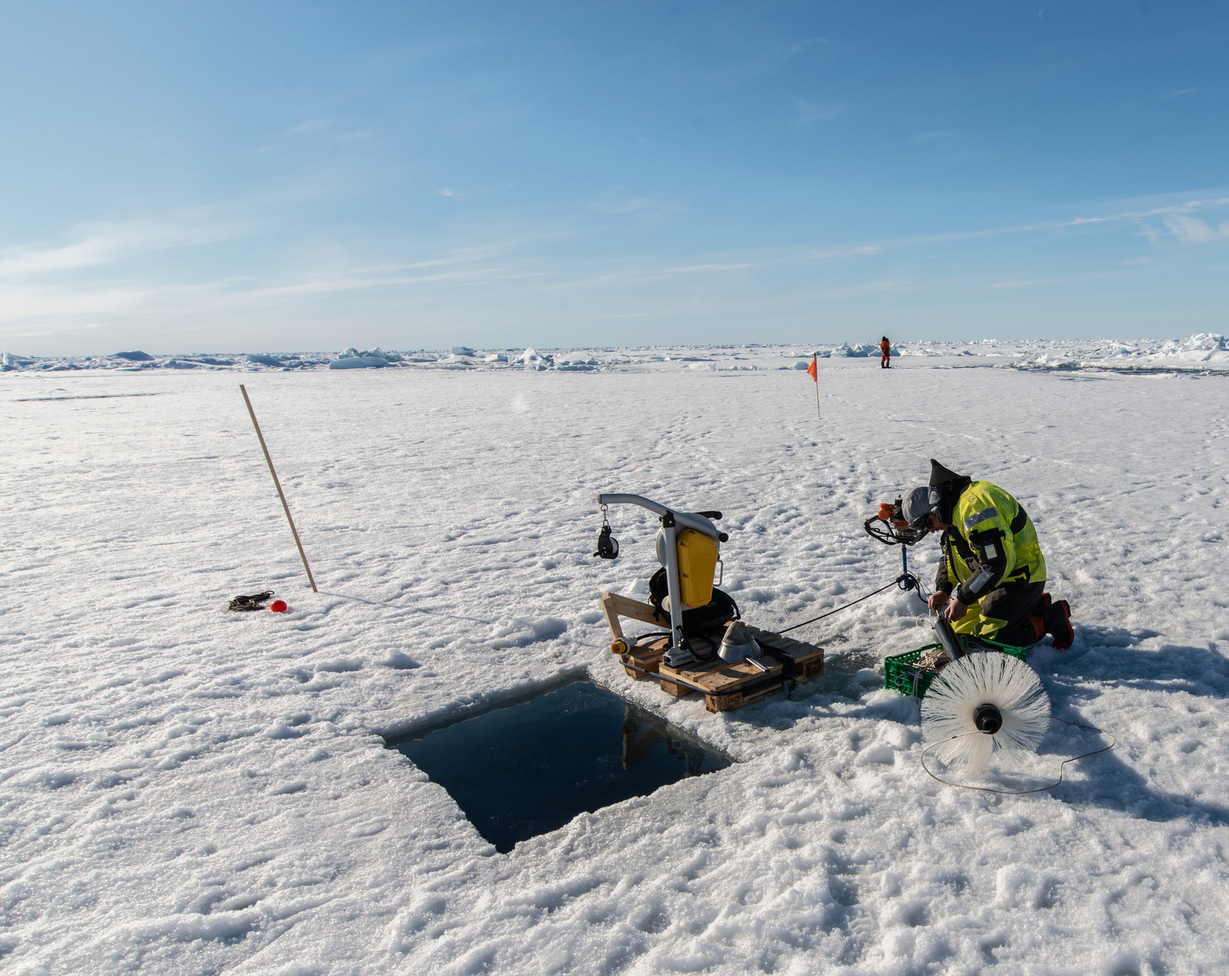
The summer is surely the best time of year to explore the Arctic.
| Access the Technical Cruise Report Here |
On board the vessel KV Svalbard an international team of experts set out to uncover some of the still hidden elements of the Arctic Ocean. The KV Svalbard of the Norwegian coast guard is a key part of the nation’s maritime arsenal, a hefty icebreaker capable of traversing some of the least hospitable ocean on the planet. This ship can reach areas of the Arctic typically covered by sea ice, allowing researchers to deploy and recover some of their high tech monitoring equipment in otherwise inaccessible locations.
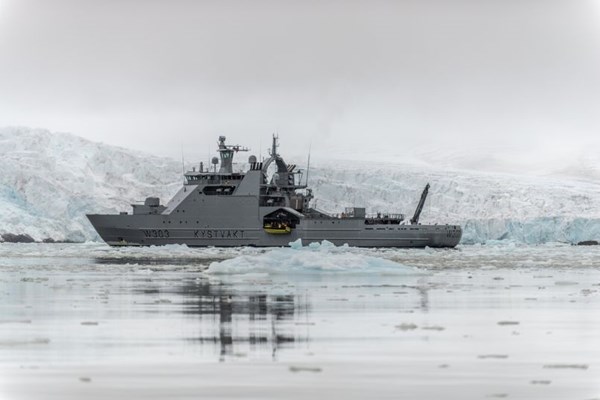
KV Svalbard
The three-week long cruise set out from Longyearbyen, Svalbard, at the end of July to carry out a wide spectrum of observations, ranging from ocean and sea ice properties, to atmospheric data and seismic activity. These measurements and observations help us to better understand the processes taking place in the ocean and to predict how these processes might change over time and interact with atmosphere above the ocean and sea ice cover.
During the first part of the trip, three ocean bottom seismometers (OBS) were deployed at around 2000 m depth near the Mid-Atlantic Ridge, a tectonically active area of the Earth’s crust, to learn more about the current level of seismic activity (earthquakes) in the area between Svalbard and Greenland. OBS are designed to record the earth motion under ocean for one year until they are recovered and data can be read out from the loggers. These ocean-bottom sensors will work together with on-land seismometers to pinpoint areas or greater seismic activity.

Jürgen Gossler (left), Zeinab Jeddi (center) and Franck Andersen (right) deploying an OBS in the Fram Strait.
The main activity during the second part of the cruise was turnaround of oceanographic moorings in the area northeast of Svalbard. Observing the ocean beyond the time period when the research vessel stays in the studied area is only possible with the help of autonomous instruments. A self-recording device remains in the water and its different sensors collect the data throughout the year, recording them in the device’s internal memory. Oceanographic moorings are a collection of self-recording instruments distributed in the water column along a wire that is anchored to the sea floor. A huge steel sphere or a package of glass balls is usually attached to the top of the wire to keep it tight in the water. The data can be recovered from moored instruments only when scientists return to the studied area in the following year and moorings are recovered. In other parts of the world ocean moorings can extend to the sea surface and measured data can be transmitted to the shore via a satellite link, but in the Arctic the sea ice cover prevents using moored rigs with a surface expression. Therefore the success of observing campaign with continuous measurements always depends on ability to recover all instruments - a challenging task in the harsh Arctic weather and ice conditions.
Four moorings recovered from KV Svalbard in 2018 had previously been deployed in the in the Arctic waters during a 2017 research cruise, gathering oceanographic data throughout the full year. During the INTAROS expedition all moorings were successfully located and released to the surface. To free a mooring from its anchor, the recovery is triggered remotely by an acoustic command to open a release hook. Buoyant floats attached to the mooring top rise it to the surface and subsequently the whole mooring length with all instruments (albeit without the anchor) is hauled in to the ship’s working deck. After the recovered instruments are detached from the wire and cleaned in the fresh water, the most exciting moment comes - reading the data records from internal loggers. There is a lot of risk with long-term autonomous measurements in the ocean. Sometimes a device stops prematurely when its battery fails, sometimes it can even get flooded when the instrument case or a connector does not withstand a mighty pressure of the water column above the mooring. But in the best case each instrument returns time series of different parameters, be it ocean temperature, salinity or speed and direction of sea current, recorded every hour (or even more often) during the entire deployment period.

Yi-Chun Chen (left), Håkon Sandven and Tor Einar de Lange (right) performing light measurements from a small-boat.
Instruments recovered during the KV Svalbard cruise included temperature and salinity point sensors and profilers, and acoustic Doppler current profilers that collect information about the physical environment in the key region north of Svalbard where warm and salty waters of the Atlantic origin enter the Arctic Ocean. Most of these instruments provided the full year of observations that will be carefully analyzed later on to extend our knowledge about how the Atlantic inflow to the Arctic influences its sea ice cover, atmospheric and oceanic circulation, and marine ecosystems.
While moorings deployed for the pilot phase of the INTAROS field experiment (2017-2018) were mainly equipped to measure physical parameters, the 2018 deployment was extended with new instrumentation, dedicated to collecting not only physical but also biogeochemical observations in the ocean. Seven new moorings were launched, bearing equipment capable of recording physical data (e.g. temperature, salinity, pressure, and ocean currents), sea ice variables (drift speed of sea ice and its draft) and biogeochemical parameters (e.g. acidity, dissolved oxygen, dissolved inorganic components, etc.). Some moorings also carried passive samplers for inorganic contaminants (e.g. microplastics). The newly developed instrument package called OCTOPUS that included the optical system (underwater camera for taking pictures of a water sample every minute to identify zooplankton and detritus) and biogeochemical sensors for measuring nitrate and chlorophyll, was attached to the central BGC (biogeochemical) mooring.

Alexandra Touzeau (right) and Nick Roden taking ice/snow samples from the sea ice.
As in the previous year, moorings were distributed along the meridional line going from the upper, shallower part of the continental slope towards the deep basin, at approximately 22°E. The mooring closest to the coast was deployed at the water depth of 500 m while the northernmost one covers the water column of about 1500 m. INTAROS moorings cut across the core of the Atlantic water current that circumvents the Arctic Ocean, being the main source of oceanic heat, nutrients and biological matter. The area north of Svalbard, where the INTAROS mooring line is located, is characterized by the most intensive interactions between Atlantic origin water and sea ice/atmosphere in the entire Arctic Ocean. One mooring was also deployed further east (as a part of the A-TWAIN observatory at 31°E) to allow studying how ocean properties change between two locations along the Atlantic water inflow pathway. All moorings and their sampling instruments will remain in the sea for the next year, all the while taking measurements of their environment.
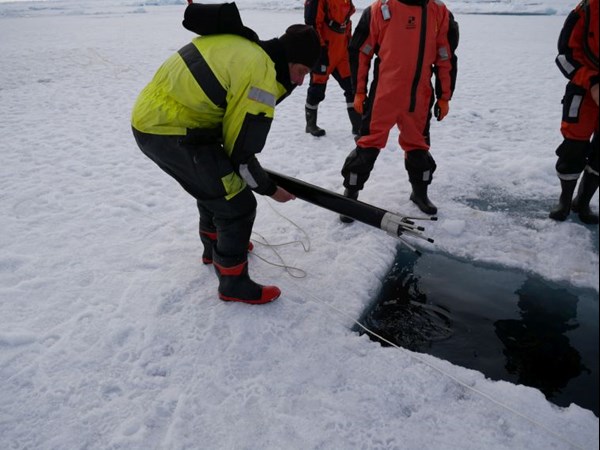
Waldemar Walczowski deploying the microstructure probe through a hole in the sea ice.
The cruise also offered an opportunity to map areas of the seabed in the vicinity of the mooring positions where the depths were poorly known previously. Detailed bathymetric maps were taken to better understand the depth profile of the region and to allow the research team to better place their in situ sampling equipment.
To complement observations with moored devices, 46 stations were occupied during the cruise to collect CTD (conductivity, temperature and depth) profiles with very high vertical resolution in the upper 1000 m of the ocean. Ocean salinity is calculated from water conductivity and measured pressure is converted to the ocean depth. CTD system, when lowered in the water column, records the data with a high frequency (8 samples per second) thus providing measurement every few tens of centimeters. For comparison, autonomous instruments distributed along the mooring wire are usually apart by a few tens or even a few hundred meters. Ship-borne CTD measurements at fixed stations provide a high-resolution ‘snapshot’ - a detailed picture of ocean state at a certain time that reveals the small-scale features and structures. CTD system also included so-called water carousel, a ring of several bottles that can be remotely closed at the selected depths. Water samples were taken daily on selected CTD stations and their physical, biogeochemical and biological properties were either analysed in the lab on board or later on land. Preliminary CTD data collected during the cruise clearly showed the contrast between the temperature and salinity distribution near the ice edge and the area across the continental slope close to the opening of the Rijpfjorden. Intensive small-scale variability was observed in the transition zone between ice-covered and open waters, and such variability can have impacts on the Arctic marine ecosystem processes, living and non-living resources, and energy flow through the system.
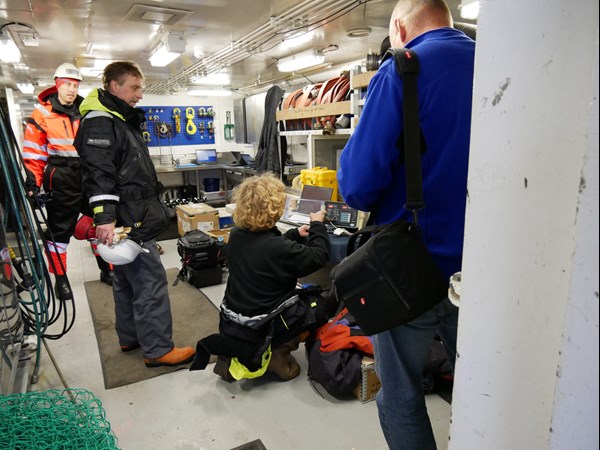
Hervé Le Goff (sitting) releasing a mooring using an acoustic signal. Nick Roden (left), Piotr Wieczorek and Tor Einar de Lange (right) watching
The multinational team of experts was coordinated by the Nansen Center, who was responsible for planning and managing the cruise in collaboration with KV Svalbard. In total 17 Scientists from Nansen Center in Bergen, three institutes at the University of Bergen (Geophysical Institute, Department of Physics and Technology, and Institute of Earth Science), Institute of Oceanology Polish Academy of Science (IOPAN), and Centre National de la Recherche Scientifique (CNRS). The scientific personnel consisted of experienced scientific and technical personnel as well as early career scientists.
The cruise leader was Hanne Sagen from NERSC, assisted for field operations by Agnieszka Beszczynska-Möller from IOPAN. During the cruise NERSC, IOPAN, UiB, and CNRS provided instrumentation as well as technical support. Additional instruments were supplied by other INTAROS partners, not participating in the cruise (AWI and NIVA). Pre-cruise logistic support was secured by Espen Storheim from NERSC and Tor de Lange from UiB-GFI.
Agnieszka Beszczynska-Möller and Marie-Noelle Houssais from CNRS were responsible for physical oceanographic measurements with the moored instrumentation and on CTD stations. Piotr Wieczorek (IOPAN) and Herve Le Goff (CNRS) were experienced mooring technicians in charge of recovery and deployment operations on deck as well as preparation of the mooring hardware. Tor de Lange was responsible for the biogeochemical instruments. Water vapour measurements were carried out during the whole cruise by INTAROS researcher Alexandra Touzeau (UiB-GFI), assisted by Harald Sodemann and Nick Roden also from UiB-GFI. Optical properties of the upper ocean were measured by Håkon Sandven and Yi-Chun Chen from the UiB Department of Physics and Technology. Yi-Chun Chen and Håkon Sandven also collected and analysed samples of surface water and sub-surface water (down to 20 m) for several sites. Waldemar Walczowski (IOPAN) was responsible for measuring ocean microstructure under different environmental conditions. The cruise was documented through film and photos by Håvard Sagen (NTNU) and Espen Storheim (NERSC).
We are extremely grateful for the support from the crew and cadets of the KV Svalbard.
Special thanks are due to the Commander G.M. Leinebø, and Lieutenant T. Vaular for all facilitation and support during planning and implementation of the cruise. Lieutenant Sletta and Lieutenant Andersen are thanked for their outstanding support during the implementation of small boat operations and operations on deck.
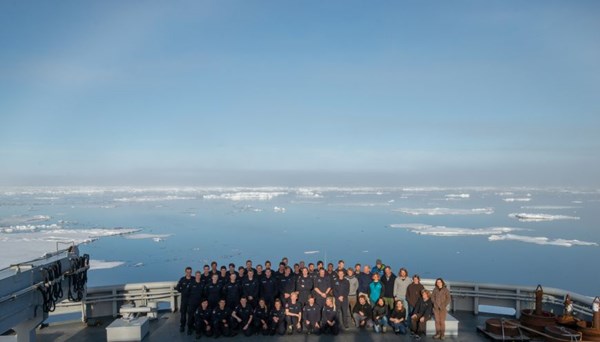
Crew and science team on deck
07/09/2018 Espen Storheim, NERSC